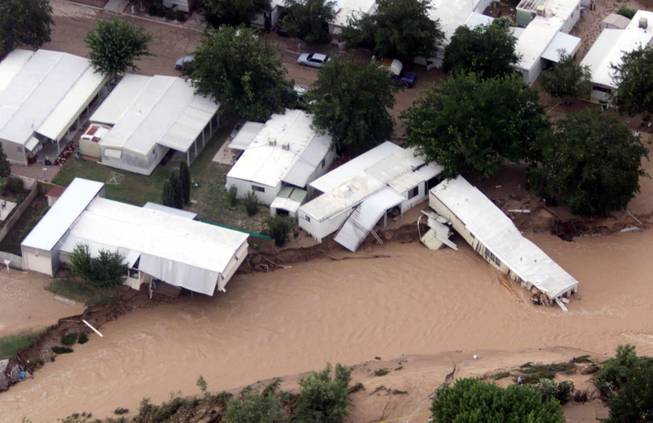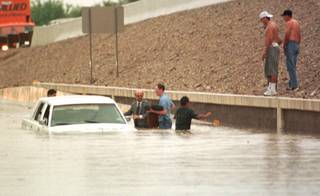
Ethan Miller / Las Vegas Sun
Homes at the Miracle Mile Mobile Home Park slide into Flamingo Wash flood waters following heavy rains on July 8, 1999. Up to three inches of rain fell around the valley causing the worst flooding since 1984, according to a spokesman with the National Weather Service. This is a photo from a KLAS-TV helicopter.
Wednesday, July 8, 2009 | 2:05 a.m.
Sun Archive
- Nevadans pleased with federal aid for flood damage (7-21-1999)
- Impact of July 8 flood still felt (8-17-1999)
- Editorial: Let’s learn a lesson from flood (7-28-1999)
- Floods, snow top Nevada weather lists (1-3-2000)
- Residents sue county over flood damage from creek (9-26-2000)
- Spencer Street bridge, closed by 1999 flood, is reopened (6-26-2002)
- Las Vegas swamped, braces for more rain (8-20-2003)
- County to pay $1.1 million to homeowners in ‘99 flood (8-21-2003)
- Las Vegas weather can be a gamble (5-15-2008)
Sun Topics
Flood fatalities
More people die each year in flash floods than any other natural disaster. The majority of these deaths are caused by unsuccessful attempts to drive through floodwater. Floodwater is dangerous. It can move as fast as 30 mph, and contains debris and other hazardous materials. It is important to stay out of flood control facilities as well. Water in flood channels and storm drains can rise as quickly as one foot a minute and can sweep you off your feet.
History of Flood/Wash Area Related Deaths in Las Vegas:
- August 1960 - One killed in flooding in Henderson
- September 1961 - One killed in Valley thunderstorm
- August 1972 - One killed in Valley floodwaters
- September 1974 - Five killed at Nelson’s Landing in Eldorado Canyon in flash flood
- July 1975 - Two killed in Valley floodwaters
- August 1982 - One killed in flooding along Blue Diamond Wash
- 1983 - One child suffocated in Flamingo Wash from loose soil (not a drowning)
- 1984 - One child suffocated in Flamingo Wash playing in loose soil (not a drowning)
- July 1984 - Two public employees drowned in LV Wash - drove into water
- September 1984 - Five drowned in Blue Diamond Wash - drove into water
- June 1990 - One drowned in Rawhide Channel - drove into water
- June 1990 - One pedestrian (teenager) fell into an opened manhole and drowned in Henderson
- July 1990 - One drowned in Flamingo Wash - drove into water
- February 1992 - One transient fell and drowned in the Charleston underpass while it was flooded
- November 1992 - One drowned in Las Vegas Wash while fishing during a heavy storm
- November 1993 - One drowned in the Las Vegas Wash (ruled accidental)
- August 1995 - One drowned - swept into Flamingo Wash (believed to be sleeping under Koval Lane bridge)
- August 1997 - One drowned at Skyline Road and Tamarack Drive in Henderson - walked into flood waters and was swept under his truck
- July 1998 - One presumed dead when flood waters swept his car off Boulder Highway in the vicinity of the Flamingo Wash
- July 1999 - One drowned at Flamingo Road and Spencer Street (believed to be a homeless person)
- July 1999 - One car accident/fatality
- December 2002 - One drowned at Sandhill Road and Washington Avenue (believed to be homeless person in storm drain)
- January 2005 - One drowned at Lake Mead Boulevard west of Interstate 15 (believed to be homeless person in a flood channel)
- September 2005 - One drowned at Lower Las Vegas Wash Wetlands Park (assumed to be flood related)
- June 2007 - Two drowned in Las Vegas Wash while fishing (not flood related)
Total Deaths: 36 (including the two child suffocations and one car fatality – not drownings); 31 directly flood-related deaths; 21 separate flash flood events
In an average year, the Las Vegas Valley gets a little more than 4 inches of rain, usually spread out in small, scattered storms.
But 10 years ago today, on July 8, 1999, more than an inch of rain fell at McCarran Airport in just one hour. Other parts of the valley received anywhere from 35 to 70 percent of the annual rainfall — between 1.5 and 3 inches, most of it in less than 90 minutes.
The rain and subsequent flash floods caused more than $20 million in property damages and took two lives, one a homeless man who was caught in flood waters and the other the result of a weather-related traffic accident.
By the end of the day, more than 150 swift-water rescues were performed by the Las Vegas and Clark County fire departments.
The damage was bad enough for President Bill Clinton to declare the area a federal disaster area.
Today, the valley is better prepared for similar storms, according to the Clark County Regional Flood Control District. But there is still work to be done.
•••
The Las Vegas Valley is especially prone to flash floods.
Unlike flooding in many other places — such as along the Mississippi River — flash floods usually only last a few hours, but they come suddenly.
Flood control district General Manager Gale Fraser tells the story of a woman who was stuck in a flash flood in the northwest valley in August 2003. When she stopped at a traffic signal, the water was at the base of her tires. By the time the light turned green, it was up to the car’s windows.
National Weather Service meteorologist Faith Borden said even a quarter inch of rain could cause a flash flood if it falls fast enough.
“The desert is conducive to flash flooding. We have very hard soil. We have a lot of concrete in the Las Vegas area,” she said. “If you get a lot of rain over a short period of time over hard soil and concrete, runoff is going to happen and flash flooding is possible.”
It is not unusual for the Las Vegas area to have one or two flash floods a year, Borden said.
Historically, floods have happened in every month of the year, but they are especially common from July to September during the monsoon season.
The valley has a number of natural washes that funnel water into the Las Vegas Wash where it goes on to Lake Mead. Normally those washes are dry, but when rain falls, they can fill quickly.
•••
On that particular day in 1999, showers and thunderstorms began about 9 a.m. By 11 a.m., storms covered most of the valley and it poured until noon, when the rainfall began to slow down.
“Virtually every major wash in the valley was flowing near capacity if not over capacity in some places,” Fraser said.
Water in one channel rose 7 feet in eight minutes. In one detention basin, it went up 14 feet in 14 minutes.
At the Gowan South detention basin near Cheyenne Avenue and Tenaya Way, the water was 22 feet deep. Just 18 more inches would have caused it to flow over its spillway.
The most memorable damage of the storm came at the Flamingo Wash near Boulder Highway and Sahara Avenue, where the wash curves through the Miracle Mile Mobile Home Park.
The swift water washed out part of Boulder Highway and eroded the banks of the wash causing a mobile home to fall into the flowing water.
At the time of the storm, the Flood Control District was working on plans to improve the wash in that area.
“Regrettably this storm didn’t happen a couple years later, because this project would have been built,” Fraser said.
•••
Gerry Hester knows the Las Vegas Wash better than most people. Now an engineering project manager for the Southern Nevada Water Authority, Hester has been working on the wash in various capacities since 1975. But the 1999 flood still stands out in his memory.
“I’ve seen bigger floods and I’ve seen the aftermath of other floods in other parts of the county, but that certainly was the biggest one on the Las Vegas Wash,” he said.
Hester said a flood on the wash is like a battlefield, loud and violent one day then quiet the next.
“It was so loud with rocks moving across each other, you could hear them clanking really loud ...To have that happen one day and then go out the next morning and see the terrain completely changed to the point that you could almost not recognize things (is impressive). And it’s so quiet in the aftermath of the flood.”
•••
While the flood control district doesn’t plan projects in response to flood damage, Fraser said, 10 years have made a big difference in flood protection efforts. “We have a plan that we’re implementing in a logical order,” he said.
At the time of the 1999 storm, the district, which was established in 1985, was still in the early stages of constructing flood control projects in the valley.
Since then, it has more than doubled the regional flood control network at a cost of $700 million – bringing it to 82 detention basins and more than 500 miles of channels and underground storm drains.
“So the area is a lot better protected,” Fraser said.
But the district is only a little more than half done and it will take another 20 years to build the remaining 56 detention basins and 329 miles of channel, he said.
“What we’re building here is the network that is going to protect this community not only for that 100-year storm but all the storms up to and including that,” he said. “It’s going to be here for generations to come because we’re funding the operation and maintenance of those, too.”
A 100-year storm has a 1 percent chance of happening in any given year, an important benchmark for flood planners.
The district sold bonds earlier this year to fund a huge new wave of construction. By the end of the year, there will be more than 30 projects under way at a cost of more than $200 million. Those projects will create 2,000 jobs.
“This is historic for the flood control district,” Fraser said. “This is the most projects under construction at one time in the history of the district.”
The district also carries out public education campaigns to remind people to stay away from floodwaters.
“There’s two things we do,” Fraser said. “One is keep floods away from people, and that’s our projects that we build, and the second thing is to keep people away from floods, and that’s as important as the first half.”


Join the Discussion:
Check this out for a full explanation of our conversion to the LiveFyre commenting system and instructions on how to sign up for an account.
Full comments policy